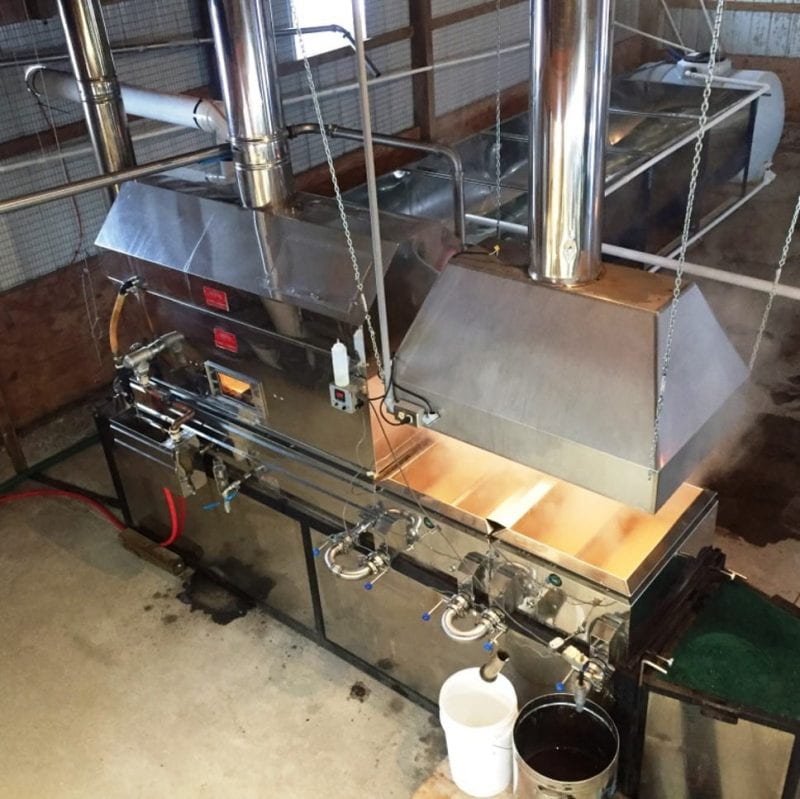Ohio Maple Days 2022 did not disappoint. The food was fantastic, the vendor room crowded, and the presenters shared a wealth of knowledge of expertise across a wide range of subjects. Joel Oelke, Regional Sales Manager with Leader Evaporator/H2O Innovation, shared an encyclopedic wealth of knowledge regarding reverse osmosis leading up to the lunch hour. Before we get into a few highlights, be sure to mark your calendars for next year’s conference December 8th and 9th!
At its simplest, reverse osmosis is a process by which sap is passed through a membrane to remove water thereby concentrating sugar. The pure water pulled out of the sap is referred to as permeate. The increasingly sugary solution – concentrate. The benefits are obvious – it saves space on numerous fronts and greatly improves efficiency at the evaporator by reducing time, fuel, and labor. While the list of pros is long, suffice it to say – reverse osmosis is one of the biggest technological revolutions the maple industry has experienced in the last 100 years.
While reverse osmosis is a true game changer for maple producers, the technology is also one of the most complex and expensive pieces of equipment in the sugarhouse. It is easy to become intimidated by what’s necessary to implement and maintain a unit, and mistakes chalked up to the “school of hard knocks” can be expensive. Here are just 5 rules of thumb that I pulled from Joel’s presentation to share in this article.
#1 – RO’s efficiency rating (how many gallons can a unit process per hour) is given at a solution temperature of 55 degrees Fahrenheit. Because sap is kept at cooler temperatures to ensure syrup quality, you need to factor the lower temperature into your unit’s efficiency rating. This is especially important to consider if you are shopping for a new RO unit. Here’s a simple figure to calibrate your RO’s operating efficiency. If you purchase a unit rated at 600 gallons per hour but expect to run sap at an average temperature of 40 F, you can multiply 600 by an efficiency downgrade of 0.75 (or 75%) and expect a 450 gallon per hour operating rate.
#2 – A second factor influencing RO efficiency is the concentrate level you are trying to achieve assuming you start around 2 Brix. The more you want to concentrate your sap, the less efficient your unit will be. Let’s continue with the example we started above in italics. If you want to take 2% sap to 8% concentrate, your RO unit will run at the temperature-corrected peak of efficiency and achieve your calibrated 450 gallons per hour rate. However, if you concentrated to something higher, say a 12% level, your operation would get dinged with an additional 30% loss in efficiency. Here’s what the math would reveal – 450 gallons per hour multiplied by 0.70 = 315 gallons per hour. Below is another figure to help you calculate the efficiency factor of concentration. Remember, you must factor in both penalties – sap temperature and concentrate level – to properly estimate your efficiency rating. And this all assumes you are running a clean, properly-maintained RO unit!
#3 – The desugaring, rinsing, and washing cycles are what keep your expensive reverse osmosis investment operating at the peak of performance. Long story short – each cycle is critical to maintaining your unit. And do not – especially in the wash cycle – generalize across all RO units. Specific models and manufacturers use different membranes which are tailored to different types of soaps and chemicals as well as amounts of each. Consulting the manuals and consulting with your RO manufacturer reps – just like Joel – is best practice for getting maximum life and performance out of your reverse osmosis technology.
#4 – Don’t let your improved efficiency get you in to trouble. What I mean is this – sap that goes through a reverse osmosis unit comes out as warmer concentrate. So, A) the process of reverse osmosis physically warms the concentrate above the temperature that it went in the machine, and B) you aren’t concentrating just sugar with an RO unit, you are concentrating everything – including microbes and bacteria. The warmer concentrate coupled with a denser community of “nasties” can get a producer in big trouble if the evaporator is not synced up in work flow and their facility can not properly keep concentrate cool. Stopping short of laying out any specific recommendations for how to integrate and streamline your sugarhouse sap-to-syrup processing, just know that the clock is ticking extra fast once you start concentrating sap.
#5 – If you properly size, run, and maintain an reverse osmosis unit, you can expect roughly a 3-year payback on your purchase when accounting for saved fuel and labor. A rough cost estimator predicted a $4 cost savings per finished gallon of syrup using fuel oil in a 110 gallon per hour evaporator. Obviously there a lot of moving parts for each unique scenario, but the bottom line is this asset does not 10 years to recoup costs.
Hopefully these quick 5 points help you make sense of reverse osmosis and how you might consider incorporating or upgrading an RO unit in your sugaring operation. Thanks for an extremely informative talk Joel!




